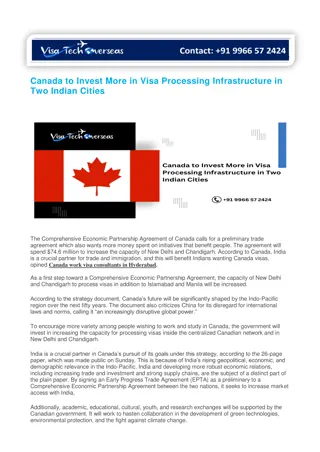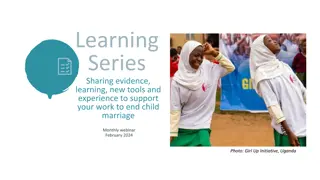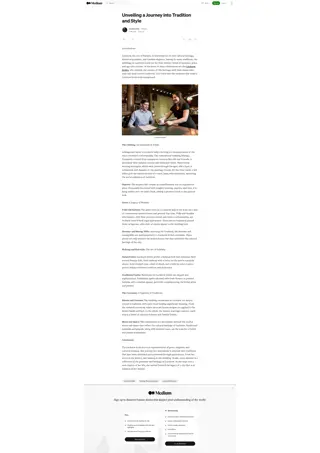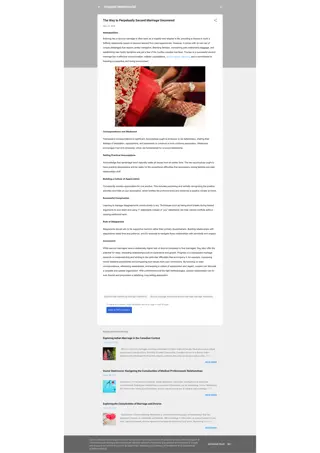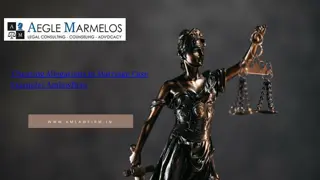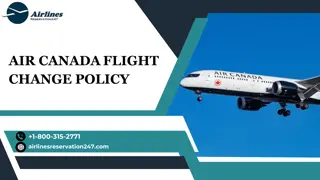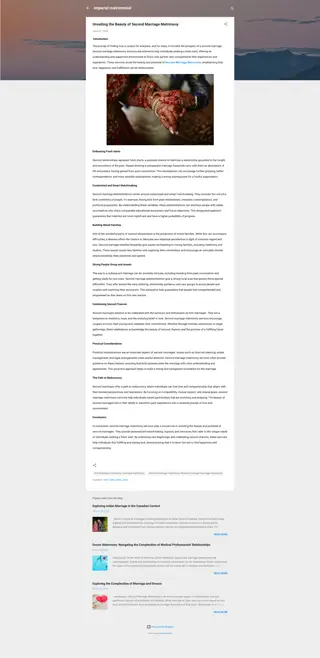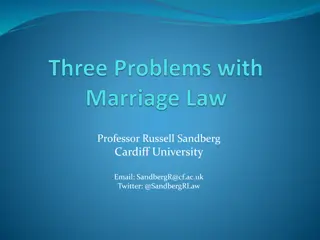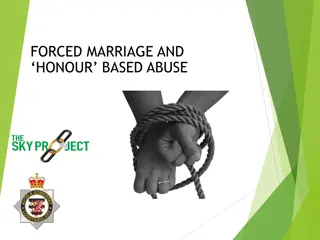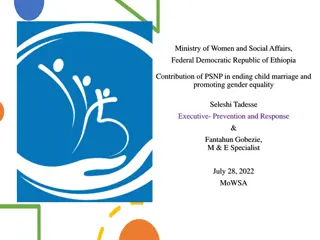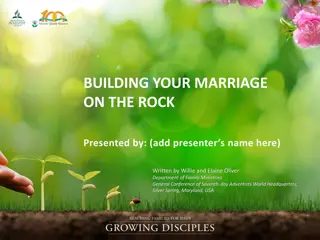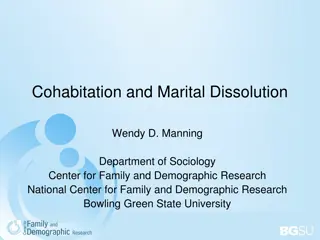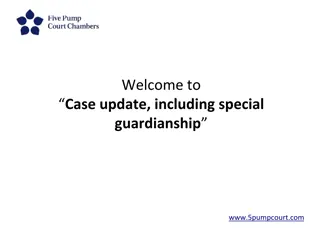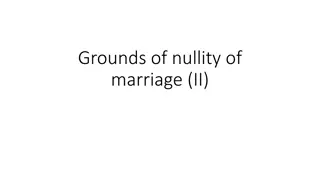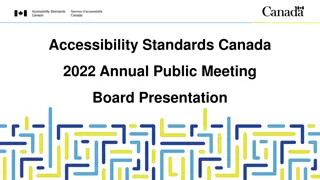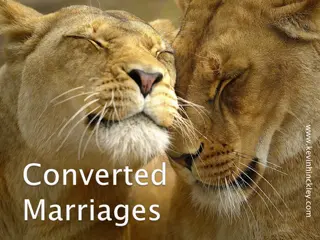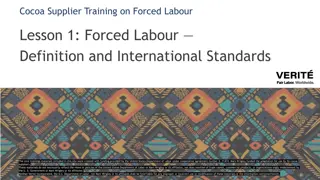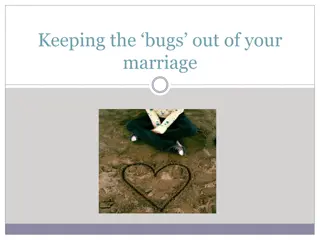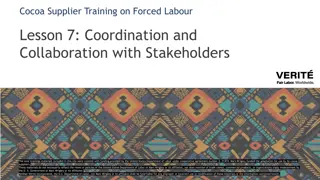Forced/Non-Consensual Marriage in Canada
South Asian Legal Clinic of Ontario (SALCO) is a legal clinic providing services to the low-income South Asian community in Toronto. The Forced Marriage Project aims to prevent coercion, promote safety, and build community accountability. Learn the difference between arranged and forced marriages and how to identify signs of forced marriage scenarios. Explore the process from parental considerations to forced marriage occurrences and the myths surrounding the topic.
Download Presentation

Please find below an Image/Link to download the presentation.
The content on the website is provided AS IS for your information and personal use only. It may not be sold, licensed, or shared on other websites without obtaining consent from the author.If you encounter any issues during the download, it is possible that the publisher has removed the file from their server.
You are allowed to download the files provided on this website for personal or commercial use, subject to the condition that they are used lawfully. All files are the property of their respective owners.
The content on the website is provided AS IS for your information and personal use only. It may not be sold, licensed, or shared on other websites without obtaining consent from the author.
E N D
Presentation Transcript
FORCED/ NON-CONSENSUAL MARRIAGE IN CANADA South Asian Legal Clinic Of Ontario (SALCO)
South Asian Legal Clinic of Ontario (SALCO) The South Asian Legal Clinic of Ontario is a community legal clinic funded by Legal Aid Ontario (LAO). We provide poverty law legal advice, representation, public legal education, community development and law reform work for the low-income South Asian community in the Greater Toronto Area. 1992 Yonge Street, Suite 205, Toronto M4S 1Z7 Tel: (416) 487 6371 www.salc.on.ca
The Forced Marriage (FM) Project Mission: Beginning a dialogue around the issue of forced/ non-consensual marriages in order to: Prevent Coercion Promote Safety, and Build Community Accountability FM Project Advisory Committee Network of Agencies Against Forced Marriages (NAAFM)
Common Myths about Forced Marriages
MYTH: There is no difference between an arranged marriage and a forced marriage. The distinction between arranged and forced marriage lies in the right to choose.
1. Parent/s start to think about their child getting married. 2. Parent/s begin to talk about their child's marriage, perhaps suggesting or looking for potential partners. 3. The topic of marriage is freely discussed, resulting in a mutual acceptance or rejection of ideas or options. 4. An agreement to marry is made. Whilst the families of those who are marrying are involved in the process, the final decision lies with those who are to be married. Arranged marriage takes place. 5. Marriage is discussed, but with no mutual acceptance or rejection of ideas. 6. There is pressure to marry, which may take the form of emotional blackmail or appeals to conform to traditional family roles and values. 7. Demands to accept a marriage proposal are accompanied by physical, mental and/or emotional pressure and violence. 8. The people concerned are manoeuvred into going through the marriage ceremony against their will. Forced marriage takes place.
MYTH: Forced Marriage is a thing of the past. Forced marriages are still occurring in many different parts of the world and the practice is receiving an increasing amount of attention. Efforts by legal workers, policy makers, service providers and community members to raise awareness and work on prevention are also expanding in response to the practice of forced marriage.
MYTH: Forced marriages are a cultural practice. In reality, forced marriages can occur in any culture, any class, any faith and in any geographical region.
MYTH: Forced marriages only happen to young women. Forced marriages have happened to people of all ages and gender. While many cases of forced marriage involve domestic violence and violence against women, many men are also victims of this practice. Forced marriage is also perpetrated against trans-gendered and trans- sexual individuals and gay and lesbian individuals, who are also vulnerable due to widespread homophobia and misconceptions about queer and trans-communities.
MYTH: Forced marriages are a private family matter. Forced marriages violate individual human rights and contravene international laws and are, therefore, not a private family matter. In many cases, the way individuals are treated to get them to agree to the marriage is also against the law.
MYTH: Forced Marriages are an immigrant issue In reality, forced marriages can occur in any culture, any class, any faith and in any geographical region.
A forced marriage is a form of violence and an abuse of human rights. It is a practice in which a marriage takes place without the free consent of the individuals getting married. Forced marriage can happen to anyone; of any gender, of any age. - SALCO/NAAFM
Forced Marriage is: An issue of violence An abuse of human rights Faced by both men and women Present across all cultural, religious and socio- economic backgrounds Experienced by minors, youth and adults of all ages Condemned in all religions and cultures
Forced Marriage is a form of violence This violence may take emotional, mental or physical forms. In a forced marriage, consent is extracted under duress, including but not limited to: fraudulent inducement, violence, physical abuse and (especially in the case of minors) psychological or emotional manipulation.
Forms of violence Physical and sexual violence Threatening behaviour Confinement Abduction Mental and social pressure using religious and cultural justifications Restrictions on lifestyle such as limitations on movement, association, dress code, education and career choices Financial control Isolation from community and family members Other demeaning, humiliating and controlling behaviour
Forced Marriage involves coercion In a forced marriage, one or both individuals are coerced into giving their consent. It is not full and free consent; to coerce someone is to force them to act or think in a certain way by use of pressure, threats, or intimidation.
Methods of coercion may include: Shaming the victim in the name of upholding the family s reputation Stressing that if the woman or man says no, it will affect their parent s health Being told that refusing will effect their siblings future chances of getting married; Threats from a parent, a sibling or a close family member to kill or harm themselves if the marriage does not take place. Inducing fear of loosing immigration status
Motives prompting Forced Marriage Each act of coercion can be read through the lens of power and control. While it is important to have an understanding of the motives that drive parents/caregivers to force their children to marry, these motives should not be accepted as justification for coercion.
Common motives for forced marriage may include: Controlling unwanted behaviour and sexuality (including perceived promiscuity, or being gay, lesbian, bisexual or transgender) particularly the behaviour and sexuality of women Protecting family honour Responding to peer group or family pressure Attempting to strengthen family and business links Ensuring land, property and wealth remain within the family Protecting perceived cultural or religious ideals Preventing unsuitable relationships, e.g. outside the ethnic, cultural, religious or caste group. Assisting claims for residence and citizenship Fulfilling long-standing family commitments
Contextualising the practice of forced marriage IMMIGRATION CONTROLS HETEROSEXISM/ TRANSPHOBIA ECONOMIC CONDITIONS CULTURAL STEREOTYPING CLASSISM RACISM/ XENOPHOBIA SEXISM/ PATRIARCHY
Addressing Forced Marriage Cases Social Service Social Change
Forced Marriage can be addressed by: Taking an anti-racist/ anti-oppressive approach Institutional commitment to fighting violence/ abuse of human rights Building public and community accountability Creating safe spaces that encourage open and inclusive dialogue Prevention-focused initiatives across communities Engaging with both youth and parents/ caregivers/family members Ensuring service to both men and women; of all sexual orientations
Warning Signs of Forced Marriages Appointments are often missed The person appears frightened, excessively anxious or depressed The person is always accompanied when attending a consultation Injuries are inconsistent with the explanation of the cause of accident One partner appears aggressive and overly dominant/the other is passive and afraid Worsening academic performance Absence or poor attendance at school, college or work Depression Self harm Eating disorders Regular visits to health care professionals with no obvious illness or reason Attempted suicide
Consequences of Forced Marriages For the Victim For the Community
Service FLOWCHART (Deepa) Case Flow Chart
Guidelines when working with people experiencing forced marriage
Guidelines Provide a Safe Environment Respect Client Rights Know the Legal Position Immigration Law Family Law Criminal Law Inform the client of their legal rights and leave it to the client s the discretion whether or not to report to law authorities. Remember, reporting may place the client at greater risk. There is one exception to what is stated above, and that is in the cases in which a client is under the age of 16.
Taking the Right Steps Initial Steps: See the person immediately in a secure and private place See the person on their own even if they attend with others Explain all the options to the person and recognize and respect their wishes. If the person does not want social services to intervene, the social worker will need to consider whether the person s wishes should be respected or whether legal reporting duties require that further action be taken Reassure the young person of social service confidentiality Initiate a strategy discussion under child protection procedures to decide whether the young person is suffering, or at risk of, significant harm (in the case of under 16s). Refer to Children s Aid Society website for more guidance. Consider the need for immediate protection and placement away from the family where necessary
Additional Steps: Information from case files and database files should be kept strictly confidential and preferably be restricted to named members of staff only. Give the young person, where possible, the choice of the race and gender of the social worker who deals with their case. Inform them of their right to seek legal advice and representation. In all cases, assess the risk of harm facing the person and the staff member. Give them personal safety advice Record any injuries and arrange a medical examination. Keep detailed documentation of any injuries or history of abuse, as the police may require this for any subsequent prosecution in related legal matters. Give the young person advice on what service they should expect and from whom. Maintain a full record of the decisions made and the reason for those decisions. Ensure that the young person has the contact details for their social worker/manager. Try to refer the young person, with their consent, to appropriate counselling services. Encourage the young person to access an appropriate, trustworthy advocacy service that can act on their behalf
Remember: Circumstances may be more complex if the person is lesbian, gay, bisexual or transgender. Male victims of forced marriage may face difficulty in getting their situation to be taken seriously. When referring a case of forced marriage to other organizations/agencies, ensure they are capable of handling the case appropriately. If in doubt, consider approaching established women s groups who have a history of working with survivors of domestic violence and forced marriage and ask these groups to refer them to reputable agencies.
Get the Details Date of report Name of individual under threat Nationality / Immigration Status Age Date and place of birth Passport details School details Employment details Full details of the allegation Name and address of parents/caregivers.
Get the Details Obtain a list from a person under threat of all those friends and family who can be trusted. Establish a code word to ensure you are speaking to the right person. Establish a way of contacting them discreetly in the future that will not put them at risk of harm. Obtain any background information including schools attended, involvement by police, doctors or other health services etc. Record details about any threats or hostile actions against the young person, whether reported by the victim or a third party.
Get the Details Obtain a recent photograph and other identifying documents. Document any other distinguishing features such as birthmarks and tattoos etc. Establish the nature and level of risk to the safety of the individual (e.g. are they pregnant, do they have a secret boyfriend/girlfriend, are they self- harming, are they already secretly married). Establish if there are any other family members at risk of forced marriage or if there is a family history of forced marriage and abuse.
Know What Not to Do Do not send the individual away in the belief it is not your responsibility Do not approach the family or friends, unless the individual asks you to do so Do not send the individual back to their family without their permission Do not breach confidentiality Do not attempt to be a mediator Do not contact community leaders unless requested to by the individual Do not disclose someone s lack of immigration status to police or immigration authorities Do not provide legal advice unless you are qualified to do so
Planning to Leave / Exit Strategies Much of the following advice also pertains to persons who may not be preparing for a planned exit, but as a means of advance preparation should an emergency exit ever be required. When devising an exit strategy the individual should be fully consulted to ascertain their future needs and have their wishes respected. Safety is paramount. Avoid putting yourself or others at risk.
Planning to Leave: Recommendations Open a bank account in his/her name Leave copies of important documents such as passport, National Insurance Number and birth certificate with the police or a trusted friend Leave spare clothing, cash, etc. with a trusted person Keep help line numbers close at hand Have a telephone card or change for urgent telephone calls Arrange alternative "emergency" accommodation should the need arise
Encourage the Individual to Consider: Who they could go to in an emergency Who would be able to send them money if necessary The possible finality of this decision
If the individual is leaving the home: Police officers should accompany them if they insist on returning to collect their possessions Consider asking a third party to collect the individuals possessions i.e. a social worker Refer the individual to appropriate agencies/support groups for information and assistance
Personal possessions to take may include: Proof of identity (something with a photograph and signature i.e. passport, student ID card, photo-card driving license, and social insurance) Medication and medical cards Address book and photographs Marriage/ divorce papers Jewellery and clothing Please note however that no possessions are more important than safety and should be left behind if necessary
Forced Marriage Abroad Canada opposes the practice of forced marriage and urges all countries to respect their international human rights obligations relating to free and full consent to marriage. Forced marriage constitutes a human rights violation under international law to which Canada is a signatory. Department of Foreign Affairs and International Trade (DFAIT)
Limitations in access to help Non-Status Refugees Citizens Temporary / Precarious Status Residents
Overseas Contact If they are already overseas or are in danger of being taken abroad, they should contact the nearest Canadian government office abroad or contact the Emergency Operations Centre at 1-800-267-6788 (in North America) or call collect at 613-996-8885 (where available)

 undefined
undefined


 undefined
undefined

